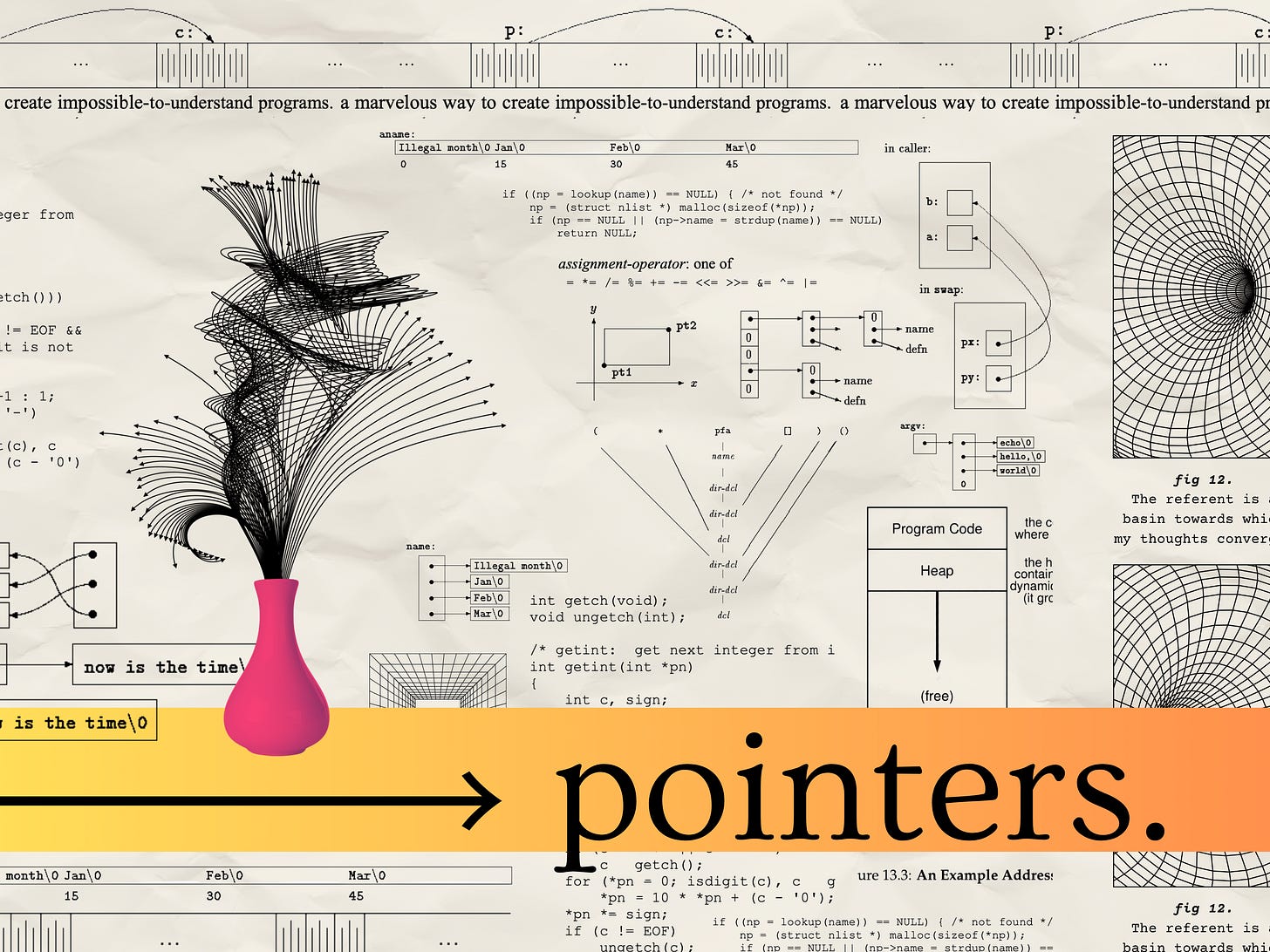Some semesters ago I took a class about the fundamental structures of computer systems. This was my introduction to the C programming language, and, additionally, my introduction to pointers. Somewhere along the way I decided to pluck this idea from the context of computing and place it in the context of thinking.
One can visualize a mental pointer as follows:
Me → A
We can translate this as “I know about A.” Under this framing, a pointer is the thought-sensation-experience which connects me (the source) to some other thought-sensation-experience (the referent).
This framing can lead to some interesting ideas when we tweak the parameters. For example, consider an indirect pointer:
Me → A → B
We can translate this as “I know about A, which knows about B.”
Indirect pointers typically form when there is a knowledge-store of any kind. I don’t bother remembering discrete objects (my passport number, some phone numbers, my passwords) when there is an easily accessible knowledge-store (my passport, my phone, my password manager). Similarly, I pay less attention to lectures when I know that there is a video recording.
Why do indirect pointers form? Well, the mind is deeply lazy: whenever possible, it will prune connections that it deems unnecessary. Two years ago, my thoughts would look like this:
“Oh, I should figure out → this math problem.”
Today, I might instead think:
“Oh, I should ask → an AI about → this math problem.”
These chains-of-thought happen very quickly, and are often flashes of feeling rather than anything deliberate. When I glance at a problem in my probability class, the pointer that springs to mind may be direct (this is how I’ll begin solving it…) or indirect (this is how I’ll form the prompt for the AI model…). Similarly, for a calculus problem, I may think either “this is how I’ll calculate the integral” or “this was mentioned in Monday’s lecture”.
All this to say that indirection comes with tradeoffs. Notice here the reduced ability to synthesize new information. When knowledge is converted to lookup, nothing is directly known by the root. Synthesis—the act of conjoining two adjacent knowledge-nodes—becomes more difficult, if not impossible, to perform.
The network itself becomes more fragile, too. If your knowledge-store disappears…
A → → C
… you are functionally left with the following:
A →
This is called a dangling pointer. It is the feeling of something on the tip of your tongue.
By contrast, a null pointer does not have a valid referent in the first place. Consider a child whose parents are attempting to pass on knowledge:
Parents → A
Child → ?
Upon hearing their stories and hard-fought lessons, the child may nod its head but proceed to dismiss them out of hand; my parents are are cliché, they speak without saying. It is only once the content is experienced firsthand that the referent is filled:
Child → A ← Parents
and the capacity for empathy is gained. I understand now what you were trying to say.
Note here that even if both of us are gesturing at the same thought-sensation-experience, the referents themselves may be of varying quality and precision. Suppose that I am in lecture. I have no doubt that the referents at which I point at are at vastly different resolution to the professor’s: I have spent three weeks in the class, and the professor has spent three decades on the subject.
We can extend this idea of low-to-high fidelity on the pointers themselves, too. Suppose I am walking along a path when I catch the scent of coffee grounds, the kind that grandma used to brew. I have encountered a long-dormant pointer to a high-resolution referent. In that instant I receive flashes of a far-too-early Saturday morning, the rich aroma of pine needles, and mourning doves murmuring underneath the opening notes of Somewhere, My Love:
Me ↝ 🏡
If I am actively attempting to recall this memory, but the pointer is too weak or too situational, I can do nothing but flail for it. It remains on the tip of my tongue.
A natural next step is to think about stronger pointers. What would it mean to strengthen this nearly-invisible pointer? What would it take to paint it neon and glowing and glittering, such that I am drawn to it at every occurrence?
Me ⇛ A
This topic of discussion—that of reducing forgetfulness, of active recall, and of expanding usable memory—is already well-trod, so I won’t discuss it here. Suffice it to say that you should imbue the referents with relevance, importance, or strong emotion.
Strong pointers are part of what we mean by subject mastery. Domain experts have a well-tuned network of strong pointers: what springs to mind is both relevant and in-depth.
But be cautious, as an abundance of strong pointers is not necessarily a good thing. Too many pointers to an unwanted referent leads to behaviors like ruminating on past mistakes or otherwise getting caught in negative thought-loops. Every experience becomes a reminder of the unwanted referent, and one’s mental activity converges toward a basin:
→ → → A ← ← ←
So, you might say, to hell with it. I’ve had enough of these pointers, let’s get rid of them entirely. If we consider direct experience, we don’t need a pointer at all, as we are immersed in the experience:
Me-World
And we can push this even further. If you’re an enlightened Buddhist, your frame might look like this:
I’ll conclude this post with that, because I’ve run out of things to point at.




